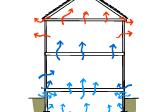
This type of ventilation takes advantage of rising heat and strategically located vents to draw air up through the top of the house, and in through the bottom of the house.

What is natural ventilation?
Natural ventilation – sometimes referred to as stack ventilation – operates on a single basic premise: warm air rises. The effect of forced stack ventilation can be seen, at a very basic level, by looking at a fireplace and a chimney. The source of the heat is low, the hot air rises and cooler air enters the shaft from below.
How natural ventilation works in houses
With respect to your home, natural ventilation principles rely on providing a passage for warm air to rise up and out through the top of the house, and for cool air to enter the house via low-lying intake vents. This works best when there is a temperature variation between the indoors and outdoors. Passive stack ventilation principles (i.e. those that don’t rely on mechanical means) can also be applied to specific areas of your home, and are often used to ventilate kitchens and bathrooms.
Whereas wind-driven ventilation relies on wind pressure differences, stack ventilation doesn’t. The vacuum effect caused by the warm air rising instead allows natural ventilation to partially restore airflow on warmer days, even if there’s not much of a breeze outside. Likewise, it allows a certain amount of freedom in terms of the position and direction from which cool air is drawn, which can be used to help improve indoor air quality. Wind direction, however, can affect stack ventilation (positively and negatively) and so should be accounted for when designing a system.
Wind ventilation and stack ventilation aren’t necessarily mutually exclusive – wind ventilation can be used to help encourage stack ventilation. Simply opening a window during a breeze can increase the air pressure lower in the house and force warm air out through roof vents.
- Locate the outlet vents as high as possible.
- Locate the inlet vents as low as possible.
- The distance between inlet and outlet vents should be as far as possible.
|
Advantages
|
Disadvantages
|
Futher reading:





